Key takeaways:
- The horror film genre has evolved from early silent films like “Nosferatu” to modern psychological horror, reflecting societal anxieties and technological advancements.
- Key milestones include films such as “Psycho,” “The Exorcist,” and “Get Out,” each revolutionizing horror by introducing new themes and techniques that resonate deeply with audiences.
- Technological innovations like CGI and sound design have transformed how fear is depicted, enhancing viewer immersion and expanding the storytelling landscape through streaming services.
- The future of horror cinema is expected to focus on immersive experiences, genre blending, and inclusivity, reflecting diverse perspectives and resonating with a broader audience.
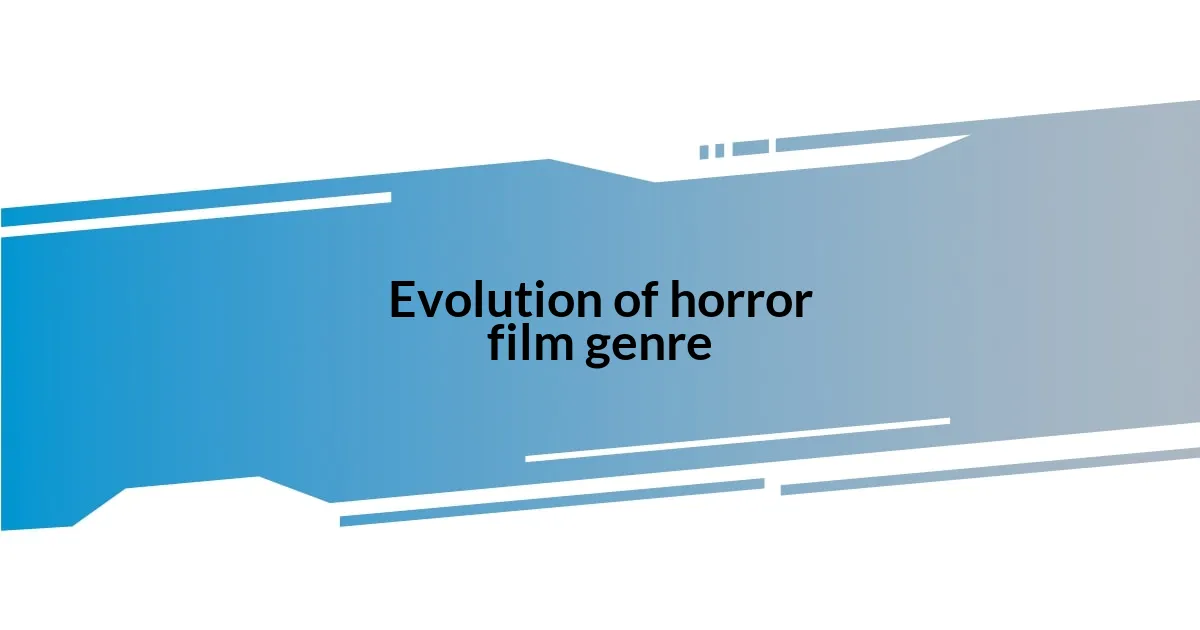
Evolution of horror film genre
The evolution of the horror film genre has been nothing short of fascinating. I remember watching classic black-and-white horror films like “Nosferatu” and “Psycho” for the first time. Their ability to convey fear without relying on the advanced special effects we have today is a testament to the power of storytelling. Don’t you think it’s amazing how fear can be evoked through atmosphere and character development alone?
As the genre progressed, we saw the emergence of the slasher films in the late ’70s and ’80s. Movies like “Halloween” and “A Nightmare on Elm Street” transformed horror into something visceral, bringing a new level of suspense and graphic violence. I think there’s something deeply compelling about how these films tapped into our primal fears of the unknown. Have you ever thought about how the depiction of evil has shifted over the years? It seems like each decade reflects societal anxieties.
More recently, horror films have taken a turn towards psychological terror and social commentary. I still recall leaving the theater after “Get Out,” feeling both disturbed and enlightened. The way this film addressed issues of race while keeping viewers on the edge of their seats was truly groundbreaking. Isn’t it interesting how horror can evolve to meet the changing concerns of society while still delivering a thrilling experience?
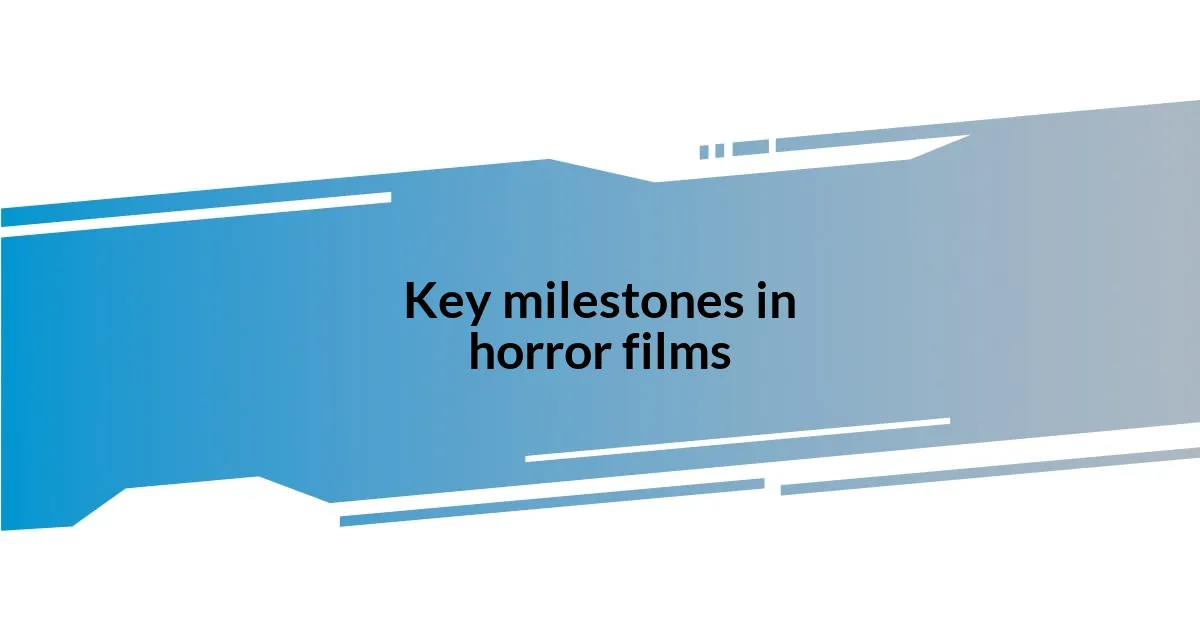
Key milestones in horror films
Throughout the years, horror films have marked pivotal points in cinematic history that have reshaped the genre. For instance, when I first watched “The Cabinet of Dr. Caligari,” I was mesmerized by its expressionist style; the twisted landscapes perfectly mirrored the psychological dread of the story. It’s remarkable to see how innovations not only frighten us but also influence our perceptions of fear itself.
- 1922: “Nosferatu” introduces the iconic vampire, setting a standard for supernatural horror.
- 1960: “Psycho” breaks the mold with its shocking plot twist and character arc, becoming a blueprint for future slasher films.
- 1973: “The Exorcist” pushes boundaries in depicting exorcism and demonic possession, causing widespread panic and fascination.
- 1980: “The Shining” showcases psychological horror with its surreal elements, profoundly affecting how viewers perceive reality.
- 2017: “Get Out” utilizes horror as a medium for social critique, proving the genre’s ability to prompt thoughtful discussions while still terrifying audiences.
Reflecting on each of these milestones evokes a sense of nostalgia and awe. I find it incredible how we’ve transitioned from silent film dread to commentary-rich narratives, each film leaving an indelible mark on our collective psyche. This evolution of horror not only reflects technological advancements but also highlights our deep-rooted fears and societal issues.
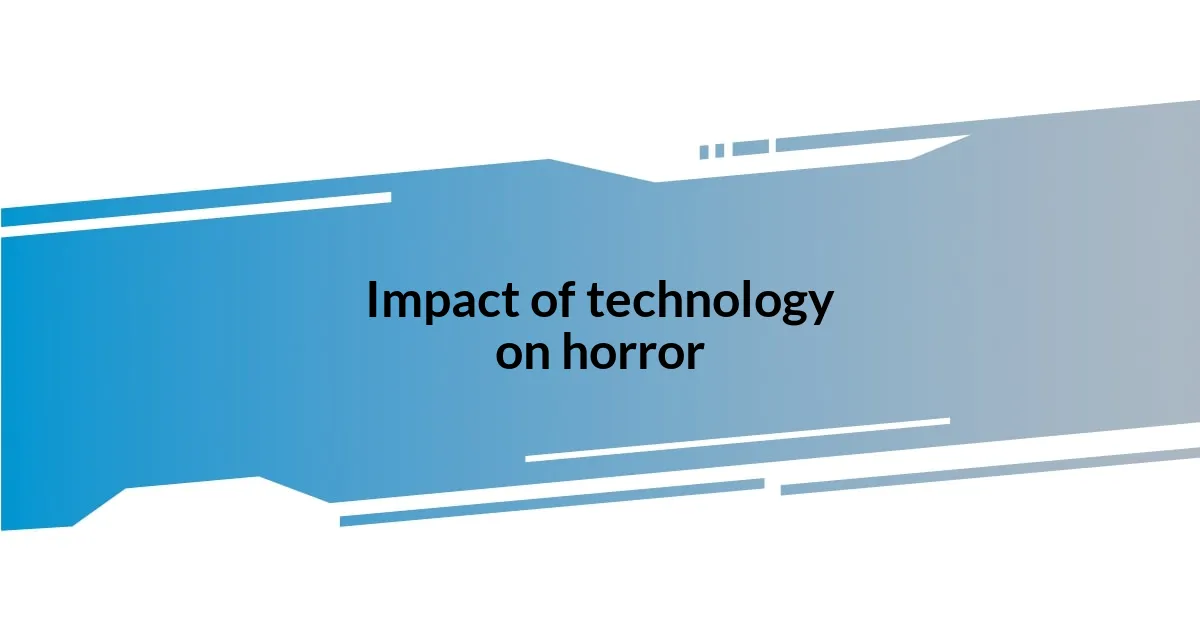
Impact of technology on horror
The impact of technology on horror films is both profound and fascinating. When I think back to my early movie-watching days, I remember how the simplest sound effects could make my heart race. Now, with advancements like CGI and surround sound, horror can create such intense immersion that it’s almost like you’re part of the story. Doesn’t it feel like technology has shifted the way fear is depicted on screen?
As filmmakers have embraced new technologies, they’ve also tapped into innovative storytelling techniques. The use of drones, for instance, offers a fresh perspective on horror scenes that were traditionally grounded at eye level. I still recall the chilling aerial shots in “The Witch” that made the isolated setting even more foreboding. It’s amazing how these technical advancements not only enhance visual storytelling but also deepen the emotional impact on viewers, making our own fears feel more tangible.
Interestingly, I’ve noticed that technology isn’t just about visuals; it also shapes how we interact with horror. With the rise of streaming platforms, horror films now reach a wider audience, allowing for diverse voices and perspectives within the genre. I remember staying up late one night, binge-watching a series of indie horror films that introduced unique narrative styles. It’s encouraging to see how technology enables different types of storytelling, reflecting a broader range of fears and themes in today’s horror landscape.
| Technology | Impact on Horror Films |
|---|---|
| CGI | Enhances visual effects, creates more realistic monsters and settings. |
| Sound Design | Intensifies atmosphere and tension, making scares more effective. |
| Drones | Provides new angles for storytelling, creating a sense of isolation or vastness. |
| Streaming Services | Increases accessibility, allowing for diverse horror narratives and voices. |
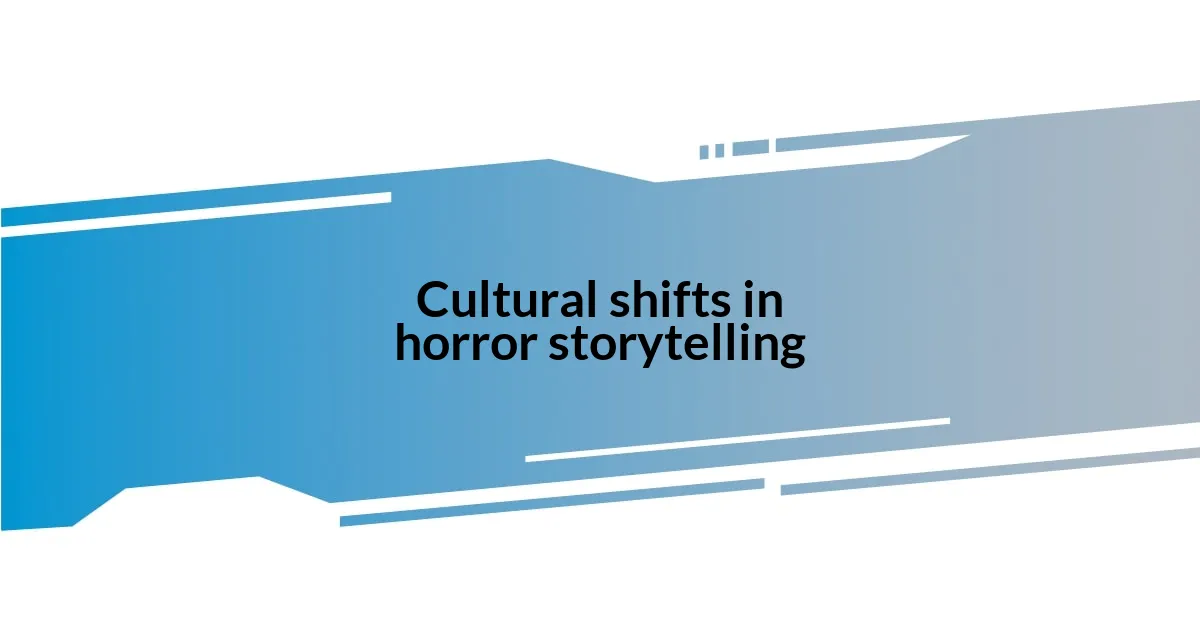
Cultural shifts in horror storytelling
Cultural shifts in horror storytelling have often mirrored societal changes, reflecting our collective anxieties and norms. I remember watching “Get Out” and feeling a mix of fear and awakening as it tackled race issues head-on, something that hadn’t been so boldly explored in earlier horror films. Isn’t it fascinating how horror can serve as a lens through which we examine societal truths and fears?
As the landscape of social issues evolves, so does the storytelling in horror. When I think of films like “Hereditary” or “The Babadook,” I can’t help but notice how they delve into themes of grief and mental illness. The way these poignant narratives channel our internal struggles makes the horror feel so much more relatable and personal. Have you ever experienced a film that resonated with your own fears in a way that it lingered long after watching it?
Ultimately, the genre is expanding beyond simple scares to encompass deeper psychological journeys. I once chatted with a friend about the resurgence of slow-burn horror films, which seem to prioritize character development and emotional stakes over jump scares. This shift is refreshing—it’s like horror is growing up, pushing boundaries and challenging us to confront the darker aspects of human nature while still providing the thrill we crave. Isn’t that what keeps us coming back for more?
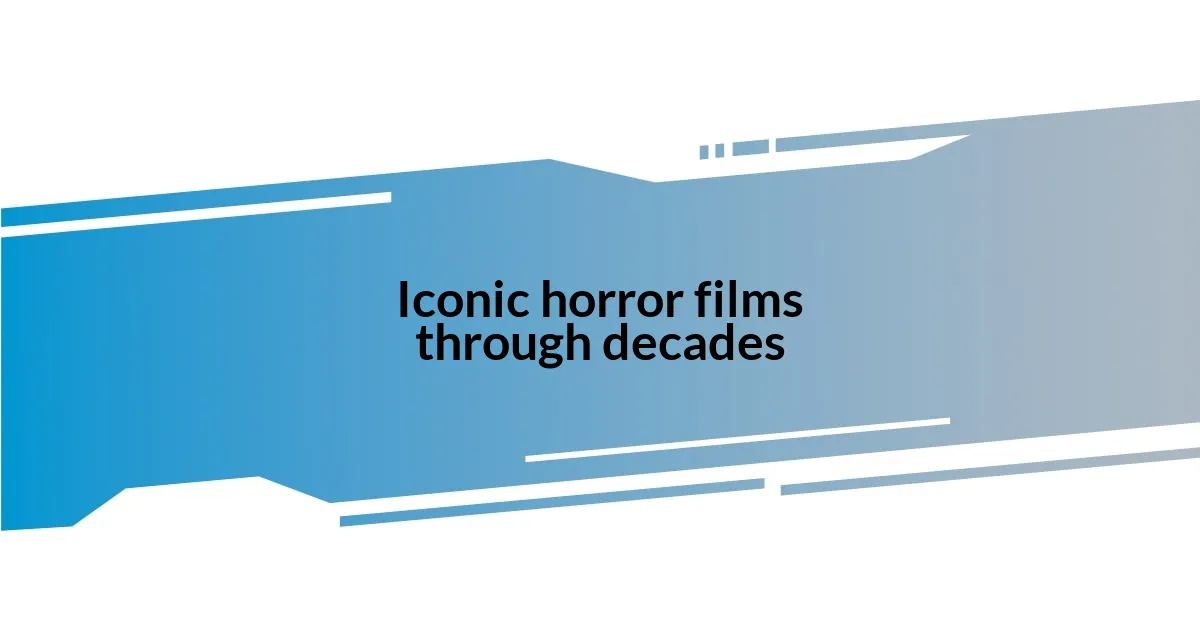
Iconic horror films through decades
When I think about iconic horror films through the decades, certain titles immediately spring to mind. The 1960s brought us “Psycho,” with its chilling score and unforgettable shower scene. I still remember the first time I watched it—it completely flipped my understanding of what suspense could be. Isn’t it incredible how a single moment can shape an entire genre?
Moving into the 1980s, “The Shining” emerged as a masterpiece of psychological horror. I vividly recall the sense of isolation permeating the Overlook Hotel, making me question everything about sanity and family dynamics. As Jack Nicholson’s character unraveled, I found myself both terrified and captivated. Doesn’t that duality of fear and fascination explain why we’re drawn to horror in the first place?
Fast forward to more recent years, and films like “A Quiet Place” redefine what horror can achieve with minimal dialogue yet maximum tension. I experienced the nail-biting silence in theaters, where you could hear a pin drop, amplifying every jump scare and moment of dread. This evolution demonstrates that horror continues to innovate, exploring new narratives while still evoking that quintessential feeling of fear. What iconic moments from horror history resonate with you?
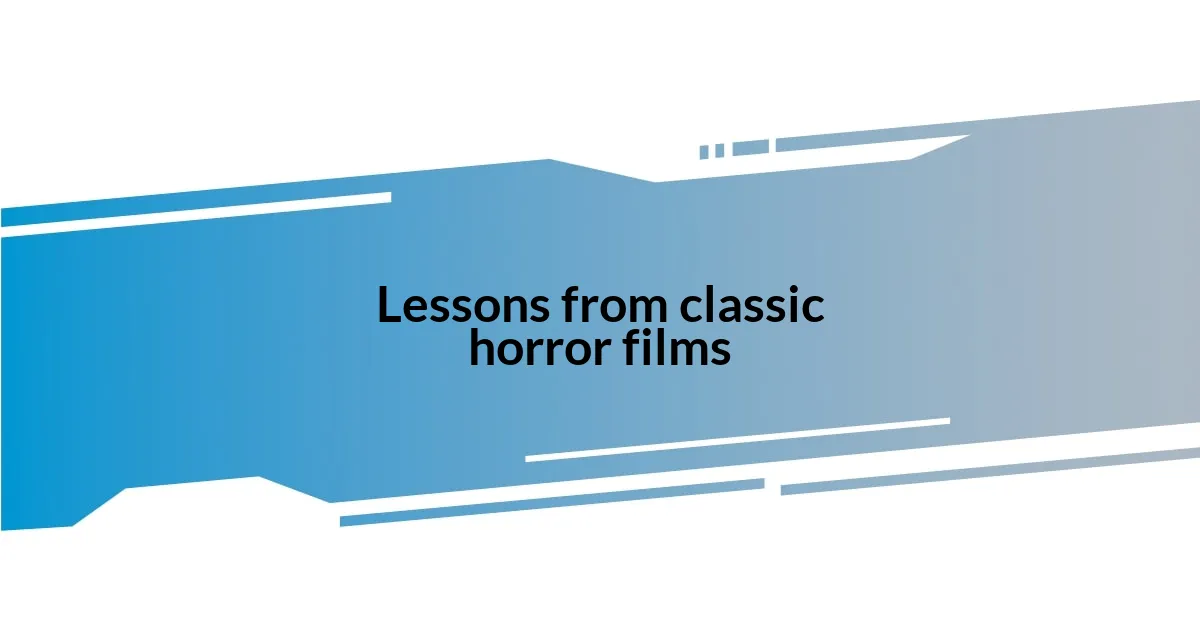
Lessons from classic horror films
Some classic horror films offer invaluable lessons about fear itself. Take “Night of the Living Dead,” for instance. I remember the first time I watched it—its stark commentary on societal issues, like race relations and fear of the unknown, left me pondering long after the credits rolled. Isn’t it intriguing how a story about zombies can unearth such deep-seated fears and prejudices?
Another lesson I find particularly enlightening comes from “The Exorcist”. This film does more than just showcase supernatural horror; it delves into the frightening complexities of faith and the struggle between good and evil. I reflect on the spiritual questions it raises, and I can’t help but wonder: how does our belief system shape our reaction to fear? Engaging with a film like this may challenge one’s perspective on morality and existence itself.
Lastly, “Halloween” can teach us about the power of anticipation in building tension. I remember being on the edge of my seat, waiting for Michael Myers to make his next move, feeling a rush of adrenaline with every creaking floorboard. This film exemplifies the notion that sometimes, what you don’t see can be just as terrifying as what you do. How powerful is it to realize that the fear of the unknown is often more impactful than the horror itself?
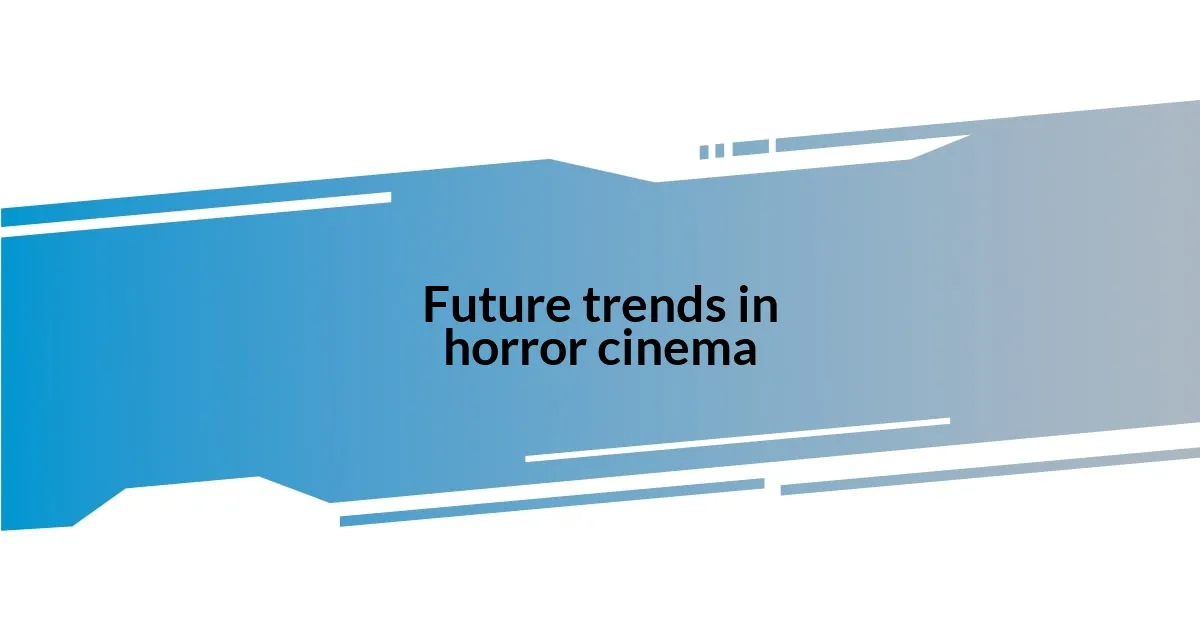
Future trends in horror cinema
As I look ahead, I can’t help but feel that technology will play a massive role in shaping the future of horror cinema. Consider virtual reality; just thinking about donning a headset and stepping into a terrifying world myself sends chills down my spine. Imagine walking through a haunted house where the suspense is not just on-screen, but all around you. Isn’t it fascinating how immersive experiences could elevate our fear to a whole new level?
I also believe that the blend of horror with other genres will become more pronounced. Take, for example, the recent surge of horror-comedies like “What We Do in the Shadows” and “The Cabin in the Woods.” They demonstrate a beautiful synergy, making us laugh while simultaneously thrilling us. From my perspective, this trend feels like a delightful rollercoaster ride—do we scream out of fear or burst into laughter? Why not both!
Moreover, I feel a growing trend toward inclusivity in horror storytelling. More diverse perspectives and narratives bring forth themes that resonate with different audiences. I can recall feeling a refreshing sense of connection while watching films like “His House,” where cultural background intertwines with horror elements. Isn’t it powerful that horror can serve as a reflection of our societal fears while also celebrating unique experiences? The evolution of horror cinema seems poised to challenge and engage us more than ever.
